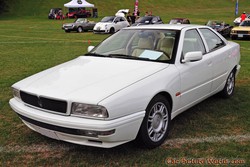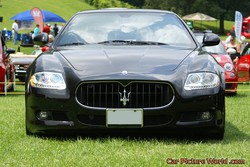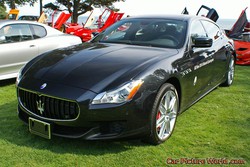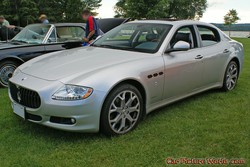Quattroporte Pictures by Model
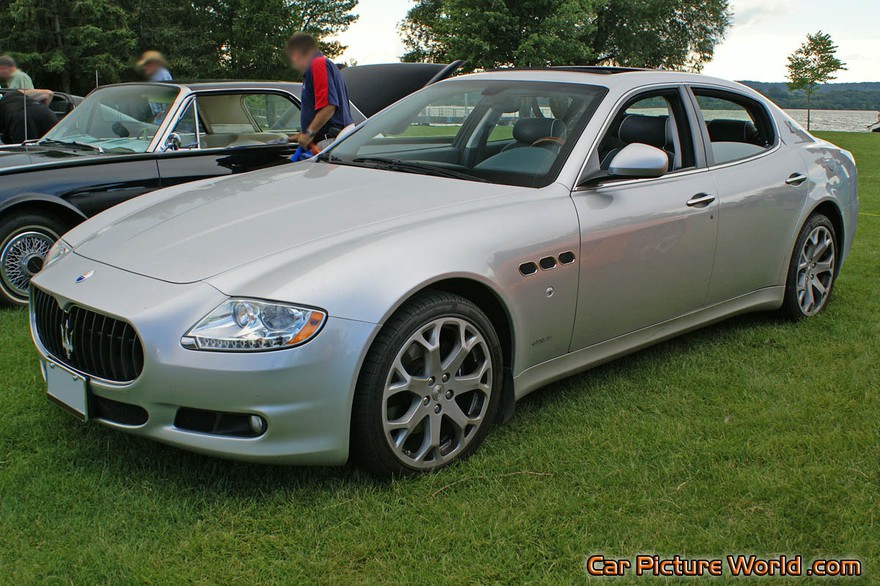
Maserati Quattroporte
The Maserati Quattroporte is a four-door luxury sedan produced by the Italian car manufacturer Maserati. The name translated from Italian literally means "four doors". There have been six generations of this car, with the first introduced in 1963, and the current model launched in 2013.
History
The original Maserati Quattroporte was built between 1963 and 1969. It was a large sedan powered by a V8 engine, both firsts for a series production Maserati.
Series I (1963-1966)
The Quattroporte was introduced at the 1963 Turin Motor Show. It was equipped with a 4.1-liter (4,136 cc or 252 cu in) V8 engine, producing 260 hp (194 kW; 264 PS) and had either a five-speed ZF manual transmission or a three-speed Borg Warner automatic. Maserati claimed a top speed of 230 km/h (143 mph). Between 1963 and 1966, 230 units were made.
(article is continued below)
Index of Maserati Quattroporte Pictures by Model
Click on the Quattroporte thumbnail or model below to see the full list of available pictures.
Maserati Quattroporte
(continued from above)Series II (1966–1969)
In 1966 the Quattroporte got twin headlights, a redesigned interior, and an optional 4.7-liter engine with 290 PS (213 kW; 286 hp). Top speed increased to a claimed 255 km/h (158 mph), making the Quattroporte 4700 the fastest four-door saloon in the world at the time. Around 500 of the second series were made.
Quattroporte II (1974–1978)
The Quattroporte II debuted at the 1974 Paris Motor Show. It was built on an extended Citroen SM chassis and featured front wheel drive and Citroen's hydropneumatic. The car had Bertone bodywork, penned by Marcello Gandini. The 3.0-liter V6 engine produced 210 PS (154 kW), giving the car a top speed of 200 km/h (124 mph). Maserati made only 13 Quattroporte IIs.
Quattroporte III/Royale (1979–1990)
The third generation Maserati Quattroporte went back to the classic formula of rear-wheel drive and large Maserati V8 engine. It was designed by Giorgetto Giugiaro. Two versions of the V8 engine were available: a 4.9 liter producing 280 PS (206 kW; 276 bhp), and a smaller 4.1 liter producing 255 PS (188 kW; 252 bhp)—later 238 hp (177 kW; 241 PS).
The Quattroporte III marked the last of the hand-built Italian cars; all exterior joints and seams were filled to give a seamless appearance. From 1987 the Royale superseded the Quattroporte.
Maserati Royale
The Maserati Royale was a built-to-order ultra-luxury version of the Quattroporte. It had a higher compression 4.9-liter engine, putting out 300 PS (221 kW; 296 bhp). The interior featured a revised dashboard with analogue clock, four electrically adjustable seats, retractable veneered tables in the rear doors and a mini-bar. Visually the Royale was distinguished by new disc-shaped alloy wheels and silver-colored side sills. Only 53 were made.
Quattroporte IV (1994–2001)
The fourth generation was built on a stretched version of the Biturbo's architecture, and used twin-turbocharged V6 and V8 engines. It was the smallest Quattroporte made. Initially it was powered by a twin-turbocharged, 24-valve V6 engine from the Maserati Ghibli. For export markets there was a 2.8-liter V6 producing 284 PS (209 kW; 280 hp) and reaching a claimed top speed of 255 km/h (158 mph).
In 1996 a 3.2-liter twin-turbocharged V8 engine with 336 PS (247 kW; 331 hp) was added to the range which gave the car a claimed top speed of 270 km/h (168 mph). Either a Getrag 6-speed gearbox or a 4-speed automatic transmissions were available.
The Quattroporte Evoluzione was introduced in 1998. It featured 400 all-new or modified parts out of a total 800 main components.
Quattroporte V (2003–2012)
The fifth generation of the Quattroporte was unveiled at the 2003 Frankfurt Motor Show. It was designed by Pininfarina and built on a new platform, being 50 cm (19.7 in) longer than its predecessor. The same chassis would be used on the GranTurismo and GranCabrio coupés and convertibles. Initially it was powered by a 4.2-liter V8 engine with an output of 400 PS (294 kW). This gave the car a 0-62 mph (0– –100 km/h) time of 5.2 seconds and a top speed of 171 mph (275 km/h).
The Maserati Quattroporte was initially offered in only one configuration, equipped with the DuoSelect transmission. The base Quattroporte DuoSelect was recognizable by its chromed grille with horizontal slats. Adaptive Skyhook suspension and 330 mm brake disks were standard.
Quattroporte Executive GT
The Quattroporte Executive GT was a luxury-oriented version. It came equipped with wood-rimmed steering wheel, an alcantara suede interior roof lining, ventilated, adaptive, massaging rear seats, rear air conditioning controls, veneered retractable rear tables, and curtain shades on the rear windows. It had 19 inch polished eight-spoke wheels and chrome mesh front and side grilles.
Quattroporte Sport GT
This version focused on performance and had a faster shifting transmission and firmer Skyhook suspension thanks to new software calibrations, seven-spoke 20 inch wheels with low-profile tires, and cross-drilled brake rotors. It had dark mesh front and side grilles and red accents to the Trident badges, like that on vintage racing Maseratis. Inside there were aluminum pedals, a sport steering wheel and carbon fibre in place of the standard wood inserts.
A new automatic transmission was introduced as an option in 2007 for all three models of the Quattroporte.
Quattroporte Sport GT S
The Quattroporte Sport GT S was introduced in 2007. Compared to the Sport GT, it had a lower ride height and 10 mm wider 295/30 rear tires, front Brembo iron/aluminum dual-cast brake rotors and red-painted six piston callipers. The cabin was upholstered in mixed alcantara and leather, with carbon fibre accents; outside the door handles were painted in body color, while the exterior trim, the 20 inch wheels, and the exhaust pipes were finished in a "dark chrome."
Quattroporte VI (2013–present)
The current sixth-generation Quattroporte was introduced in early 2013. With a 3,171 mm (124.8 in) wheelbase, it is larger than any of its predecessors and sets itself apart from the smaller Maserati Ghibli, which shares its underpinnings. Engine choice includes twin-turbocharged V6 and V8 petrol engines, as well as a turbodiesel.
Drive-trains, platform, suspension, and body elements such as the front doors are common to the Quattroporte and the smaller Ghibli sedan. Initially the range included the V8 twin-turbo, rear-wheel drive Quattroporte GTS and the V6 twin-turbo, Quattroporte S, available with Q4 all-wheel drive and rear-wheel drive depending on the market. The flagship GTS can be distinguished from its trapezoidal instead of round tail pipes. A V6 turbodiesel model for European markets was introduced in 2013.
The 3.0-liter (182 cu in) 60° V6 produces 404 bhp (301 kW; 410 PS), while the 3.8-liter 90º V8 produces 523 bhp (390 kW; 530 PS). Both use one turbocharger per cylinder bank, twin intercoolers, and are direct injection. A 3.0-liter V6 diesel engine is also available, with 275 PS (202 kW; 271 bhp) The 2014 Quattroporte GTS accelerated from 0-60 in 4.2 seconds, and ran the 1/4 mile in 12.7 seconds in Car and Driver's December, 2014 road test.
This article uses material from the Wikipedia article "Masearti Quattroporte" and is a modified version of said article. It is released under the Creative Commons Attribution-Share-Alike License 3.0. This license does not apply to the accompanying photographs.
- Home
- Alfa Romeo
- AMC
- Aston Martin
- Audi
- Austin Healey
- Avanti
- Bentley
- BMW
- Bricklin
- Buick
- Cadillac
- Chevrolet
- Chrysler
- Citron
- Cobra
- Corvette
- Daimler
- Delorean
- Detomaso
- Dodge
- Fiat
- Fisker
- Ford
- Ferrari
- GMC
- Hot Rods
- Jaguar
- Jensen
- Lamborghini
- Lancia
- Lincoln
- Lotus
- Marcos
- Maserati
- Maybach
- McLaren
- Mercedes
- Mercury
- MG
- Morgan
- Mustang
- Nissan
- Oldsmobile
- Plymouth
- Pontiac
- Porsche
- Rolls Royce
- Rover
- Saleen
- Studebaker
- Tesla
- Triumph
- TVR
- Viper
- Classic Cars
- Other Cars
- Terms of Use
- Privacy Policy
- About & Contact
- Search



